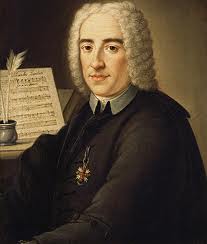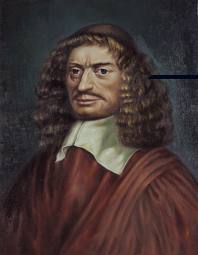April 28, 2014.Alessandro Scarlatti and Giacomo Carissimi.Alessandro Scarlatti’s birthday is this week.He was born on May 2nd of 1660 in Palermo, Sicily.When he was 12, he moved to Rome, and soon after found the patronage of Queen Christina.In 1684 Scarlatti moved to Naples, where he became the maestro di capelle at the royal court (we wrote about this period of his life at length a year ago).He stayed in Naples till 1702 and then moved to Florence.He wrote four operas for the Prince Ferdinando III de Medici and then moved back to Rome..By 1707 he was working for the Cardinal Ottoboni, the great patron of arts and music.That year he wrote the opera Il Mitridate Eupatore.It was premiered in Venice and was received poorly.Now it is considered (and is) one of Scarlatti’s finest.The role of Mitridate was written for a castrato but these days it’s sung by sopranos, and so is another leading role, that of Mitridate’s sister, Laodice.Here’s her aria Di Mitridate genitor... Dolce stimola al tuo bel care, sung by the incomparable Joan Sutherland.We know that in a few years Scarlatti would be eclipsed by the young Handel, but it seems that this music is on the level of the greatest arias Handel ever wrote.Edmond Appia conducts the BBC orchestra.And here’s another one of Laodice’s arias, Dolce cara allegrezza inaudita, from the same production (we have to concede that the voice of La Stupenda brings all music she sings to a different level).And of course we should remember the wonderful aria Cara tomba of the protagonist, Mitridate.It’s beautifully sung by the German coloratura Simone Kermes.
Giacomo Carissimi was 55 years older than Scarlatti.Whereas Scarlatti worked when Baroque was already a highly developed, established style, Carissimi was an early Baroque composer.He was born around April 18th of 1605 (that’s the day of his baptism) in Marino, near Rome.We know that at the age of 20 he became a maestro di capelle in Assisi.In 1628 he moved back to Rome to assume the same position at Collegium Germanicum, the post held by many great composers, Tomás Luis de Victoria one of them.He stayed at the College and it’s church, Sant'Apollinare, for the rest of his life, even though he received invitations from many places, including the offer to take over Claudio Monteverdi’s position at San Marco in Venice.Carissimi was one of the first composers to develop the musical form of oratorio based on the text from an episode in the Bible, with soloists, choir, and the Narrator, whose recitatives linked the story together.This genre has stayed popular ever since. It reached its pinnacle with Johann Sebastian Bach (the Passions) and Handel (Messiah), but Mendelssohn in the 19th century, and both Stravinsky and Penderecki in the 20th produced masterpieces.One of Carissimi’s best-known oratorios is Jephte, written around 1650.It’s based on a story from the Book of Judges.You can hear it in the performance by the ensemble Cantus Cölln, Konrad Junghänel conducting.Carissimi, who never wrote operas, was instrumental in developing cantatas, which are in many ways similar to shorter operas.He died on January 12th, 1674.By then, the Baroque style was predominant, in no small measure propelled by Carissimi’s work.
Alessandro Scarlatti and Giacomo Carissimi, 2014
April 28, 2014. Alessandro Scarlatti and Giacomo Carissimi. Alessandro Scarlatti’s birthday is this week. He was born on May 2nd of 1660 in Palermo, Sicily. When he was 12, he moved to Rome, and soon after found the patronage of Queen Christina. In 1684 Scarlatti moved to Naples, where he became the maestro di capelle at the royal court (we wrote about this period of his life at length a year ago). He stayed in Naples till 1702 and then moved to Florence. He wrote four operas for the Prince Ferdinando III de Medici and then moved back to Rome.. By 1707 he was working for the Cardinal Ottoboni, the great patron of arts and music. That year he wrote the opera Il Mitridate Eupatore. It was premiered in Venice and was received poorly. Now it is considered (and is) one of Scarlatti’s finest. The role of Mitridate was written for a castrato but these days it’s sung by sopranos, and so is another leading role, that of Mitridate’s sister, Laodice. Here’s her aria Di Mitridate genitor... Dolce stimola al tuo bel care, sung by the incomparable Joan Sutherland. We know that in a few years Scarlatti would be eclipsed by the young Handel, but it seems that this music is on the level of the greatest arias Handel ever wrote. Edmond Appia conducts the BBC orchestra. And here’s another one of Laodice’s arias, Dolce cara allegrezza inaudita, from the same production (we have to concede that the voice of La Stupenda brings all music she sings to a different level). And of course we should remember the wonderful aria Cara tomba of the protagonist, Mitridate. It’s beautifully sung by the German coloratura Simone Kermes.
royal court (we wrote about this period of his life at length a year ago). He stayed in Naples till 1702 and then moved to Florence. He wrote four operas for the Prince Ferdinando III de Medici and then moved back to Rome.. By 1707 he was working for the Cardinal Ottoboni, the great patron of arts and music. That year he wrote the opera Il Mitridate Eupatore. It was premiered in Venice and was received poorly. Now it is considered (and is) one of Scarlatti’s finest. The role of Mitridate was written for a castrato but these days it’s sung by sopranos, and so is another leading role, that of Mitridate’s sister, Laodice. Here’s her aria Di Mitridate genitor... Dolce stimola al tuo bel care, sung by the incomparable Joan Sutherland. We know that in a few years Scarlatti would be eclipsed by the young Handel, but it seems that this music is on the level of the greatest arias Handel ever wrote. Edmond Appia conducts the BBC orchestra. And here’s another one of Laodice’s arias, Dolce cara allegrezza inaudita, from the same production (we have to concede that the voice of La Stupenda brings all music she sings to a different level). And of course we should remember the wonderful aria Cara tomba of the protagonist, Mitridate. It’s beautifully sung by the German coloratura Simone Kermes.
Giacomo Carissimi was 55 years older than Scarlatti. Whereas Scarlatti worked when Baroque was already a highly developed, established style, Carissimi was an early Baroque composer. He was born around April 18th of 1605 (that’s the day of his baptism) in Marino, near Rome. We know that at the age of 20 he became a maestro di capelle in Assisi. In 1628 he moved back to Rome to assume the same position at Collegium Germanicum, the post held by many great composers, Tomás Luis de Victoria one of them. He stayed at the College and it’s church, Sant'Apollinare, for the rest of his life, even though he received invitations from many places, including the offer to take over Claudio Monteverdi’s position at San Marco in Venice. Carissimi was one of the first composers to develop the musical form of oratorio based on the text from an episode in the Bible, with soloists, choir, and the Narrator, whose recitatives linked the story together. This genre has stayed popular ever since. It reached its pinnacle with Johann Sebastian Bach (the Passions) and Handel (Messiah), but Mendelssohn in the 19th century, and both Stravinsky and Penderecki in the 20th produced masterpieces. One of Carissimi’s best-known oratorios is Jephte, written around 1650. It’s based on a story from the Book of Judges. You can hear it in the performance by the ensemble Cantus Cölln, Konrad Junghänel conducting. Carissimi, who never wrote operas, was instrumental in developing cantatas, which are in many ways similar to shorter operas. He died on January 12th, 1674. By then, the Baroque style was predominant, in no small measure propelled by Carissimi’s work.
Germanicum, the post held by many great composers, Tomás Luis de Victoria one of them. He stayed at the College and it’s church, Sant'Apollinare, for the rest of his life, even though he received invitations from many places, including the offer to take over Claudio Monteverdi’s position at San Marco in Venice. Carissimi was one of the first composers to develop the musical form of oratorio based on the text from an episode in the Bible, with soloists, choir, and the Narrator, whose recitatives linked the story together. This genre has stayed popular ever since. It reached its pinnacle with Johann Sebastian Bach (the Passions) and Handel (Messiah), but Mendelssohn in the 19th century, and both Stravinsky and Penderecki in the 20th produced masterpieces. One of Carissimi’s best-known oratorios is Jephte, written around 1650. It’s based on a story from the Book of Judges. You can hear it in the performance by the ensemble Cantus Cölln, Konrad Junghänel conducting. Carissimi, who never wrote operas, was instrumental in developing cantatas, which are in many ways similar to shorter operas. He died on January 12th, 1674. By then, the Baroque style was predominant, in no small measure propelled by Carissimi’s work.